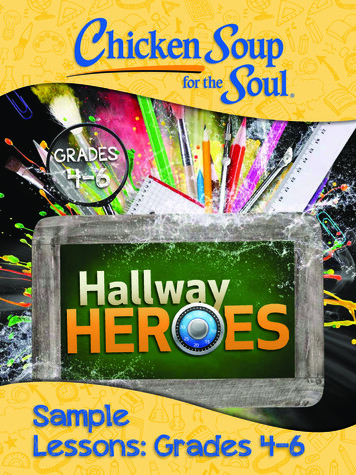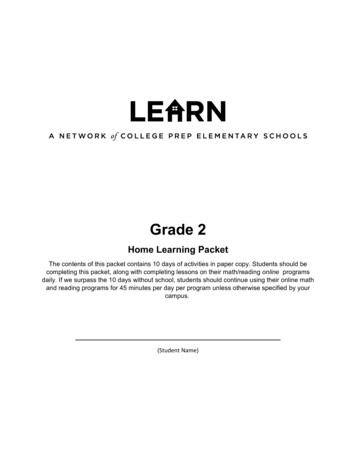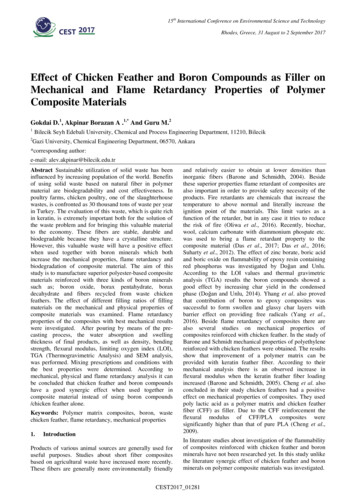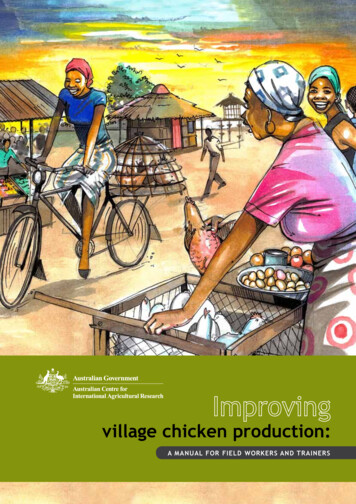
Transcription
GRADES4– 6GRADE 5SampleLessons: Grades 4–6
Sample LessonsGRADES 4-6CSSBoniukChicken Soup for the Soul Publishing, llcCos Cob, CT
These lesson plans werecreated by Resources for Learning, LLC.With support from:www.theboniukfoundation.orgPublished by CSS Boniuk, an imprint of Chicken Soup for the Soul Publishing, llcwww.chickensoup.com. Copyright 2015 by Chicken Soup for the Soul Publishing, llc.All Rights Reserved.CSS Boniuk, CSS, Chicken Soup for the Soul, Hallway Heroes, and its Logo and Marks are trademarks ofChicken Soup for the Soul Publishing, llc.Cover and Interior Design & Layout by Daniel Zaccari.Student Journal Page Design by Resources for Learning, Christy Cox.Back cover photo courtesy of iStockPhoto.com/Kesu01 ( Kesu01).Front cover and interior hand-painted illustrations courtesy of iStockPhoto.com/joebelanger ( joebelanger).No part of this book may be reproduced by any means without written permission from the publisher exceptin the case of certain pages that may be reproduced for classroom use and are so indicated.ISBN: 978-1-942649-46-5p r i n t e d i n t h e u n i t e d s tat e s o f a m e r i c a25 24 23 22 21 20 19 18 17 16 15 01 02 03 04 05 06 07 08 09 10 11
INTRODUCTIONINTRODUCTIONWelcome to our sampler book of lessons for Chicken Soup for the Soul Hallway Heroes!For more than 20 years, educators have used our books in classrooms to encouragereading, offer advice and support, and provide a resource for students of all ages. Nowwe’ve teamed up with education experts and the non-profit Boniuk Foundation to bring youthis literacy-based anti-bullying and social-emotional development program for first throughsixth grades.We are passionate about this program and the power of storytelling to improve youngminds. We’re excited that you are considering using Chicken Soup for the Soul HallwayHeroes in your school. Let’s create heroes not only in our school hallways, but also inclassrooms, on playgrounds, in homes, online, and in our communities.Chicken Soup for the Soul Hallway Heroes was developed using a modification of thehighly successful 5E learning cycle and instructional model. The 5E model uses the followinginstructional elements: engage, explore, explain, elaborate, and evaluate. That model isenhanced by adding two additional elements—elicit and extend—to create a 7E model inthis program.We are excited that you and your school have chosen to consider our program. If youhave any questions, or need further information, please visit www.chickensoup.com/hallwayheroes.m3 Proactive Anti-Bullying Progra3 Social and Emotional Learning3 Literacy-Based Lesson PlansSkills
What you will find inside:ofInside this sampler book you will find one complete sample lesson for eachvisitingGrades 4–6. You’ll find sample lessons for Grades 1–3 on our website bychickensoup.com/hallwayheroes.edThe full program has 12 lessons per grade level (Grades 1-6), each designyto take 30-50 minutes. The lessons are designed to be taught during literacnalemotioblocks of time, and they are aligned to the literacy and sociallearning standards for each of the 50 states and national standards.ple lessonmastelepmocEachincludes:in this bookletourd lesson plan fromsebayacerlit A1.Teacher Guidedthe lesson is basechhiwonyorstul: Be the2. The real-lifen Soup for the SokeicChokboefrom thBest You Can Bee lessonurnal pages for thJotenudSthe T3.Lesson plans inclu1. Pre-reading activityde:and discussion2. Reading a story from Chicken Soup for the Soul:Be the Best You Can Be—the story addressesbullying or related situations3. Classroom discussions after reading the story4. Students answering questions in their studentjournals about the story and how it pertains totheir experiences5. Students responding to prompts in their studentjournals—including open-ended writing andpersonal narratives
LESSON 7Grade 4“Losing an Enemy” p. 163Description of LessonSEmpathy and compassion can be antidotes for negativebehaviors such as bullying and cyberbullying. In this lesson,students will identify bullying behaviors and brainstormconstructive ways to handle them. The Hallway Heroes bookcomes one step closer to completion as students give extensive feedback to one another regarding their personal narratives.AMaterials One TV Talk Show Card for each group of four students (p. 91 of the Teacher Guide)M One copy of Narrative Peer Feedback form (p. 93 of the Teacher Guide) for each student7Lesson Objectives Address bullying situations by applying constructive approaches to resolving conflictsthrough compassion and kindnessLiteracy ObjectivesP Explain how family members, peers, school personnel, and community members cansupport school success and responsible behaviorLE Develop a narrative that includes a setting, characters, a narrator, a conflict, and a resolution Analyze and evaluate the writing of a peer and provide constructive feedback forimproving his or her personal narrativeTeacher DirectionsElicitAdditional TeacherPreparation & NotesThe teacher asks students what they think of when they hear theword bullying, and calls on volunteers to share their thoughts.The teacher then says: “We have been learning about empathyand compassion. How do you think empathy and compassionare related to bullying?” The teacher asks students to discuss thisquestion with a partner or in small groups.LESSON 7 GRADE 486
Teacher DirectionsAdditional TeacherPreparation & NotesEngageSThe teacher asks students to stand up. The teacher explains thathe or she will read some statements about bullying aloud andidentifies which side of the room is the “agree” side and whichside of the room is the “disagree” side. When each statement isread, students who agree with the statement, or feel the statement is true for them, move to one side of the room. Studentswho disagree with the statement, or feel it is not true for them,move to the other side of the room. The teacher then reads eachstatement aloud, pausing to give students a chance to move. Aftereach statement, the teacher asks if anybody wants to share reasons for their choices or to give an example of the statement. Thestatements are as follows:A“Bullying is a behavior that is unwanted.”“Bullying is a behavior that happens only one time.”“Bullying is a behavior that occurs when somebody uses powerto gain control of somebody else.”M7“Bullying only happens in person, when two or more people arein the same room together.”“I have been bullied before.”“I have been somebody who has exhibited bullying behavior.”“I have stood up against bullying.”Sensitivity Alert: Studentsmay identify as being bullied or students may beuncomfortable identifyingas being bullied in frontpeers. Before askingquestions, the teachershould remind studentsof the Classroom RespectPledge and that this isa safe environment forsharing. The teachershould also give studentsthe option to not sharepersonal experiences.If the teacher suspectsbullying is a currentissue for any students,he or she should alsoinvestigate and addressthe issue.P“I have witnessed bullying behavior.”Teachers in classroomswith students who havemobility issues can askstudents to raise handsor use other signals toindicate agreement ordisagreement, ratherthan moving around theroom.LE Chicken Soup for the Soul Publishing, LLC87 LESSON 7 GRADE 4
Teacher DirectionsAdditional TeacherPreparation & NotesExploreStudents either follow along as the teacher or other students read“Losing an Enemy,” p. 163, or they read the story to themselves.At the end, the teacher asks the students about their reactions tothe story: “What were some reasons why John treated others theway he did in the beginning of the story? What roles did compassion and empathy play in this story?”SExplainAThe teacher explains that the behavior exhibited by John in thestory is considered to be bullying behavior. The teacher explains:“In bullying situations, there are usually bystanders, people whowitness the bullying behaviors. These bystanders can help thesituation, make the situation worse, or do nothing. Bothbystanders and those who experience bullying situations canreact as the author and his family did—with compassion andkindness. Bullying situations should be reported to a trustedadult like the brothers in the story did in discussing the situationwith their parents.”M7PThe teacher asks students: “In the story, the bullying Patty Anneexperiences happens in person. Where are some other placesbullying can happen?” If students fail to mention the Internet,the teacher asks students if they have heard of cyberbullying.Students share what they think cyberbullying is, and examples ofcyberbullying.Before the lesson, theteacher should review theschool or district’s bullying policy to see localdefinitions and policies.Stopbullying.gov definesbullying as “unwanted,aggressive behavioramong school-agedchildren that involves areal or perceived powerimbalance. The behavioris repeated, or has thepotential to be repeated,over time.”LEThe teacher asks students: “What are some places online that wetalk to or about other people? What are some reasons peoplemight say or do things on the Internet they wouldn’t do in person? Why is it important to be careful about what we do online?What are some things you can do when you see cyberbullying?What ways can we be Hallway Heroes online?” The teacherreinforces that the same rules on tattling and reporting wouldapply to cyberbullying and how it’s important not to respond tonegative posts on the Internet.Bullying can take manyforms, including social,emotional, physical, orcyber (occurring online).The teacher may alsochoose to have a list ofobserved bullying behaviors he/she can referenceif the student responsesare limited.Examples of places onlineinclude: social media,email, text messages,online games. Chicken Soup for the Soul Publishing, LLCThe teacher reinforces to students that online posts hurt othersjust as much or more as saying it in person and that oncesomething is posted online it can be difficult, and sometimesimpossible to erase.LESSON 7 GRADE 4 88
Teacher DirectionsAdditional TeacherPreparation & NotesThe teacher explains that students will practice using compassionand kindness to respond to bullying and cyberbullying situationsin the “TV Talk Show” activity.With minor modifications,the teacher can customizeeach talk-show card to fitthe gender distribution ofthe class.SThe teacher organizes students into groups of four and explainsthat each scenario has four roles: the host, the person exhibitingbullying behavior, the person experiencing the bullying behavior,and the bystander. The teacher or students assign each of theroles to one person in the group. The teacher gives each studentgroup a different TV Talk Show Card, located on p. 91-92 of theTeacher Guide. The teacher explains that when the host asks thegroup a question, they are to answer as if they are the characterassigned.When students have had the opportunity to practice their rolesin the talk show, the teacher asks a few groups to volunteer toperform in front of the class. At the end of each talk show, thehost asks the audience for strategies that the person experiencingthe bullying behavior and the bystander can use to respond tothe bullying behavior. Students in the audience take notes on theStrategies for Dealing with Bullying Behaviors page, located on p.32 of the Student JournalM7AStudents practice acting out the interviews. The teacher circulates,asking questions or assisting students as needed.Cyberbullying lying.com/cyber-bullying-factsPSensitivity Alert: Theteacher should be awareof scenarios that mayclosely relate to students’real lives. Be mindfulof placing students inscenarios that may causeadditional stress orhardshipLEEvaluateStudents complete the journal entries for Lesson 7, located on p.32-36 of the Student Journal.Students conduct a peer review of the revised story they wrotein the previous lesson. Students find the partner who gave themfeedback on their writing in previous meetings and use theNarrative Peer Feedback form, located on p. 93 of the TeacherGuide, to provide extensive feedback to one another on theirmost recent drafts. The teacher models giving peer feedback usingthe story, “Losing an Enemy,” p. 163, projecting the form andthinking aloud as he or she fills out the form.The teacher can revieweach student’s story,as well as the peerfeedback, providing anyadditional commentsnecessary before the nextlesson. Chicken Soup for the Soul Publishing, LLC89 LESSON 7 GRADE 4The teacher may wantto use whatever instructional methods and toolshe or she uses to guidepeer conferencing in thewriting process.
Teacher DirectionsAdditional TeacherPreparation & NotesExtendPrompt students withexamples of places onlinewhere bullying can occur:email, text messages,social media, onlinegames.Student groups develop their own scenarios for the “TV TalkShow” activity. Ask the groups to write a new scenario aboutbullying behavior online, and to come up with advice for thecharacters in the scenario.SAssessmentStudents assess personal strengths and areas of growth and give constructive feedback to a peerregarding his/her personal narrative.AStudents identify strategies that people in bullying situations can use to show one another compassion and kindness.Journal Prompts Lesson Response: Strategies for Dealing with Bullying BehaviorsM7What are some reasons someone might exhibit bullying behavior? What roles can empathy and compassion play in bullying situations? How can cyberbullying be similar or different to bullying behaviors experienced in person?PWhat are some ways you can respond to bullying behaviors you see online? Chicken Soup for the Soul Publishing, LLCLELESSON 7 GRADE 490
PROBLEM CARDSShow 1Background Information:Jacob is in fourth grade and has three brothers who are in high school. They tease and pickon him. They usually make him do their chores and retaliate with violence if he tries to standup for himself. Jacob replicates his brothers’ behavior at school, picking on a boy namedJamal after Jamal refuses to share the answers to his math assignments with Jacob. Thishappens everyday for a week. Lee, Jamal’s friend, witnesses this behavior.SInstructions:1. Host introduces the guests and describes the situation.2. Host asks each guest questions.M7ASuggested questions:“What role did you play in this situation? What decisions did you make?”“What feelings did you experience in this situation? What were the causes of thesefeelings?”“What advice or strategies does anybody from the audience have for Jacob, Jamal,or Lee?”Show 2PBackground Information:Maria creates a fake social media account, pretending to be Jackie, a quiet girl in her class.On this account, Maria posts negative things about other people in her class. Soon, peoplewho used to be Jackie’s friends at school no longer want to be her friend because of theposts Maria is making, pretending to be her.LEInstructions:1. Host introduces the guests and describes the situation.2. Host asks each guest questions.Suggested questions:“What role did you play in this situation? What decisions did you make?”“What feelings did you experience in this situation? What were the causes of thesefeelings?”“What words of advice or strategies does anyone in the audience have to give Jackie tohelp her stand up against bullying behavior?” Chicken Soup for the Soul Publishing, LLC91 LESSON 7 GRADE 4
PROBLEM CARDSShow 3Background Information:Eric is struggling in math. He hates to raise his hand in class because he thinks he always getsthe wrong answer. When this happens, he notices people snickering under their breath. Erictries to take the focus off of himself by turning his peers’ attention to the new student, Ray,by making negative comments about the clothes Ray wears.SInstructions:1. Host introduces the guests.2. Host asks each guest questions.ASuggested questions:“What role did you play in this situation? What decisions did you make?”“What feelings did you experience in this situation? What were the causes of thesefeelings?”“What words of advice or strategies does anyone in the audience have to give Ray to helphim stand up against bullying behavior?”M7Show 4PBackground Information:Ashley’s mom is sick in the hospital. Ashley misses her and thinks about her all the time.Ashley notices that Valentina, a girl in her class, always has her hair in a French braid. Ashleyis certain that Valentina’s mom probably helps her style it every morning. Ashley wishes hermom could braid her hair like Valentina’s. Instead of giving Valentina a compliment, Ashleyyanks on the braid and says it’s a hairstyle for little girls. She has done this every day sinceher mom got sick.Suggested questions:LEInstructions:1. Host introduces the guests.2. Host asks each guest questions. Chicken Soup for the Soul Publishing, LLC“What role did you play in this situation? What decisions did you make?”“What feelings did you experience in this situation? What were the causes of thesefeelings?”“What words of advice or strategies does anyone in the audience have to give Valentina tohelp her stand up against bullying behavior?”LESSON 7 GRADE 4 92
Name: Name of Partner:NARRATIVE PEER FEEDBACKStep 1: Read your partner’s story from beginning to end. Read it as many times as you need tountil you feel you completely understand the author’s message. Write down your initial responses to the story by responding to the prompts below:My favorite part of your story was:SAYour story made me feel:The lesson I learned from your story was:M7PStep 2: Go back to the story: Does the story start with an introduction, describing what the author is going to talk about?If so, label it with the word introduction.LE Where are the beginning, middle, and end? Label the location where each one starts on yourpartner’s paper. Who are the main characters? Write their names where they are introduced. Does the story start with “action” that draws the reader in? Mark it with the word action onyour partner’s paper.Is the story written in past tense? Circle one: YES NOCount the number of words, and write your total here:93 LESSON 7 GRADE 4 Chicken Soup for the Soul Publishing, LLCIs the story longer than 1200 words? Circle one: YES NO
Name: Name of Partner:NARRATIVE PEER FEEDBACK continuedIf your partner’s story is longer than 1200 words, what are some suggestions for how yourpartner can condense this story, but keep the important elements?SAWrite any other suggestions you have for how to improve the story:M7P Chicken Soup for the Soul Publishing, LLCLELESSON 7 GRADE 494
Displayed in actual sizeSALosing an EnemyMLIf your enemy is hungry, feed him;if he is thirsty, give him something to drink. Romans 12:20Past year, my brothers were enrolled in Pioneer Clubs, a weeklykids program at our church. Daniel was nine, and Timothywas seven. My sister, my dad and I were all teachers at thesame church program. At one point during the year, my brothers began to complain that a boy named John was picking on them.John, an eleven-year-old foster boy, was in my dad’s class. Hewas the type of kid who always seemed to be in trouble. Worse, hedidn’t consider that it was his behavior that was the problem, butinstead decided my dad was picking on him. He often took it out onmy brothers by knocking off their hats, calling them names, kickingthem and running away. Even I received the occasional rude remarkfrom John. We all thought he was a real pain.When my mom heard about the problem, she came home fromtown a few days later with a bag of wrapped butterscotch candies.“These are for John,” she told Daniel and Timothy.“For who?”“For John.” Mom went on to explain how an enemy could beconquered by kindness.It was hard for any of us to imagine being kind to John; he wasso annoying. But the next week the boys went to Pioneer Clubs withLEHandling Bullies : Losing an Enemy 163GRADE 4
Displayed in actual sizeSbutterscotch candies in their pockets — one for themselves and onefor John.As I was heading to my class, I overheard Timothy saying, “HereJohn, this is for you.” When we got home, I asked Timothy what John’sresponse had been.Timothy shrugged. “He just looked surprised, then he said thankyou and ate it.”The next week when John came running over, Tim held on to hishat and braced himself for an attack. But John didn’t touch him. Heonly asked, “Hey, Tim, do you have any more candy?”“Yep.” A relieved Timothy reached into his pocket and handedJohn a candy. After that, John found him every week and asked for acandy, and most times Timothy remembered to bring them — one forhimself, and one for John.Meanwhile, I “conquered my enemy” in another way. One time asI passed John in the hall, I saw a sneer come over his face. He startedto open his mouth, but I said, “Hi, John!” and gave him a big smilebefore he had a chance to speak.Surprised, he shut his mouth, and I walked on. From then on,whenever I saw him I would greet him with a smile and say, “Hi, John!”before he had a chance to say anything rude. Instead, he started tosimply return the greeting.It’s been a while since John picked on my brothers, and he’s notrude to me anymore, either. Even my dad is impressed with the changein him. He’s a nicer John now than he was a year ago — I guess becausesomeone finally gave him a chance.He wasn’t the only one to change. My whole family learned whatit meant to love an enemy. What’s strange is that in the process, welost that enemy — he was “conquered” by love.Love: It never fails.AMPLE Patty Anne Sluys164Losing an Enemy : Handling BulliesGRADE 4
Instructions on how to use the Student Journal are found in the corresponding Lesson Plan.Displayed in actual size“Losing an Enemy” page 163LESSON7 7LESSONLesson Response: Strategies for Dealing with Bullying --------------------------------32 LESSON 7GRADE 4 Chicken Soup for the Soul Publishing, --
Instructions on how to use the Student Journal are found in the corresponding Lesson Plan.Displayed in actual size !!!!!!!!!!S!! !!!!!!!!!!!!!!!!!!!!!!!!!!!!! !!!!!!!!!!!!!!!!!!!!!!!!!!!!!! !!!!!!!!!!!!!!!!!!!!!!!!!!!!!! !!!!!!!!!! !!!!!!!!!!!!!!!!!!!!!!!!!!!!!!!!!!!!!!!!!!!!!!!!!! !!!!!!!!!!!!!!!!!!!!!!!!!!!!!!!!! !!!!!!!!!!!!!!!!!!!!!!!!!!!!!!!! !!!!!!!!!!!!!! Chicken Soup for the Soul Publishing, !!!!!!!!!! LESSON 7 33GRADE 4
Instructions on how to use the Student Journal are found in the corresponding Lesson Plan. Displayed in actual size AMP34 LESSON 7GRADE 4 Chicken Soup for the Soul Publishing, LLC Chicken Soup for the Soul Publishing, !!!!!!!!!!!!!!!!!!!! !!!!!!!!!!!!!!!!!!!!!!!!!!!! !! !!!!!!!!!!!!!!!!!!!!!!!!!!!! !!!!!!!!!!!!!!!!!!!!!!!!!!!! !! !!!!!!!!!!!!!!!!!!!!!!!!!!!!!! !!!!!!!!!!!!!!!!!!!!!!!!!!!!!! !!!!!!!!!!!!!!!!!!!!!!!!!!!!!! !!!!!!!!!!!!!!!!!!!!!!!!!!!! !! !!!!!!!!!!!!!!!!!!!!!!!!!!!!!! !! !!!!!!!!!!!!!!!!!!!!!!!!!!!! !! !!!!!!!!!!!!!!!!!!!!!!!!!!!! !! !!!!!!!!!!!!!!!!!!!!!!!!!!!! !!!!!!!!!!!!!!!!!!!!!!!!!!!!!! !! !!!!!!!!!!!!!!!!!!!!!!!!!!!! !! !!!!!!!!!!!!!!!!!!!!!!!!!!!! !!!!!!!!!
Chicken Soup for the Soul Publishing, LLC Chicken Soup for the Soul Publishing, LLC LSSN 7 88RAD 4 LSSN 7 RAD 4 7 7 Teacher Directions Additional Teacher Preparation & Notes Explore Students either follow along as the teacher or other students read “Losing











